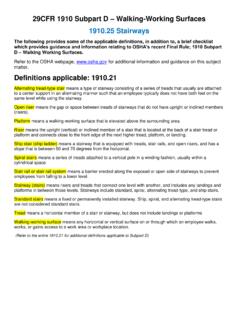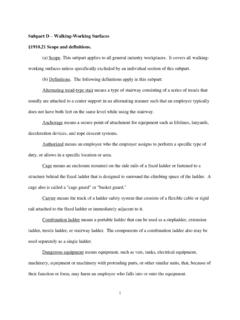Transcription of OSHA’s Final Rule to Update, Align, and Provide Greater ...
1 FactSheetOSHA s Final Rule to Update, Align, and Provide Greater Flexibility in its General Industry walking - working surfaces and Fall Protection StandardsBackgroundFalls from heights and on the same level (a working surface) are among the leading causes of serious work-related injuries and deaths. OSHA estimates that, on average, approximately 202,066 serious (lost-workday) injuries and 345 fatalities occur annually among workers directly affected by the Final standard. OSHA s Final rule on walking - working surfaces and Personal Fall Protection Systems better protects workers in general industry from these hazards by updating and clarifying standards and adding training and inspection requirements.
2 The rule affects a wide range of workers, from window washers to chimney sweeps. It does not change construction or agricultural rule incorporates advances in technology, industry best practices, and national consensus standards to Provide effective and cost-efficient worker protection. Specifically, the rule updates general industry standards addressing slip, trip, and fall hazards (subpart D), and adds requirements for personal fall protection systems (subpart I). OSHA estimates this rule will prevent 29 fatalities and 5,842 lost-workday injuries every rule benefits employers by providing Greater flexibility in choosing a fall protection system.
3 For example, it eliminates the existing mandate to use guardrails as a primary fall protection method and allows employers to choose from accepted fall protection systems they believe will work best in a particular situation an approach that has been successful in the construction industry since 1994. In addition, employers will be able to use non-conventional fall protection in certain situations, such as designated areas on low-slope roofs. As much as possible, OSHA aligned fall protection requirements for general industry with those for construction, easing compliance for employers who perform both types of activities. For example, the Final rule replaces the outdated general industry scaffold standards with a requirement that employers comply with OSHA s construction scaffold rule phases out a 1993 exception for the outdoor advertising industry that allows qualified climbers to forego fall protection.
4 At least three workers have fallen from fixed ladders under this exception. One of them died. The Final rule phases in the fixed ladder fall protection requirements for employers in outdoor advertising. Fall Protection OptionsThe rule requires employers to protect workers from fall hazards along unprotected sides or edges that are at least 4 feet above a lower level. It also sets requirements for fall protection in specific situations, such as hoist areas, runways, areas above dangerous equipment, wall openings, repair pits, stairways, scaffolds, and slaughtering platforms. And it establishes requirements for the performance, inspection, use, and maintenance of personal fall protection defines fall protection as any equipment, device, or system that prevents a worker from falling from an elevation or mitigates the effect of such a fall.
5 Under the Final rule, employers may choose from the following fall protection options: Guardrail System A barrier erected along an unprotected or exposed side, edge, or other area of a walking - working surface to prevent workers from falling to a lower level. Safety Net System A horizontal or semi-horizontal, cantilever-style barrier that uses a netting system to stop falling workers before they make contact with a lower level or obstruction. Personal Fall Arrest System A system that arrests/stops a fall before the worker contacts a lower level. Consists of a body harness, anchorage, and connector, and may include a lanyard, deceleration device, lifeline, or a suitable combination.
6 Like OSHA s construction standards, the Final rule prohibits the use of body belts as part of a personal fall arrest system. Positioning System A system of equipment and connectors that, when used with a body harness or body belt, allows a worker to be supported on an elevated vertical surface, such as a wall or window sill, and work with both hands free. Travel Restraint System A combination of an anchorage, anchorage connector, lanyard (or other means of connection), and body support to eliminate the possibility of a worker going over the unprotected edge or side of a walking - working surface. Ladder Safety System A system attached to a fixed ladder designed to eliminate or reduce the possibility of a worker falling off the ladder.
7 A ladder safety system usually consists of a carrier, safety sleeve, lanyard, connectors, and body harness. Cages and wells are not considered ladder safety Descent SystemsThe rule codifies a 1991 OSHA memorandum that permits employers to use Rope Descent Systems (RDS), which consist of a roof anchorage, support rope, descent device, carabiners or shackles, and a chair or seatboard. These systems are widely used throughout the country to perform elevated work, such as window rule adds a 300-foot height limit for the use of RDS. It also requires building owners to affirm in writing that permanent building anchorages used for RDS have been tested, certified, and maintained as capable of supporting 5,000 pounds for each worker attached.
8 This mirrors the requirement in OSHA s Powered Platforms Safety RequirementsFalls from ladders account for 20 percent of all fatal and lost work-day injuries in general industry. The new rule includes requirements to protect workers from falling off fixed and portable ladders as well as mobile ladder stands and platforms. (The ladder requirements do not apply to ladders used in emergency operations or ladders that are an integral part of or designed into a machine or piece of equipment). In general, ladders must be capable of supporting their maximum intended load, while mobile ladder stands and platforms must be capable of supporting four times their maximum intended load.
9 Each ladder must be inspected before initial use in a work shift to identify defects that could cause Ladders Fixed ladders are permanently attached to a structure, building, or equipment. These include individual-rung ladders, but not ship stairs, step bolts, or manhole steps. The new rule phases in a requirement for employers to have ladder safety or personal fall arrest systems for fixed ladders that extend more than 24 feet, and phases out the use of cages or wells for fall protection under the following timeline: Starting in two years, all new fixed ladders and replacement ladder/ladder sections must have a ladder safety or personal fall protection system.
10 For existing ladders, within two years, employers must install a cage, well, ladder safety system, or personal fall arrest system on fixed ladders that do not have any fall protection. Within 20 years, all ladders extending more than 24 feet must have a ladder safety or personal fall arrest system. Portable Ladders Portable ladders usually consist of side rails joined at intervals by steps, rungs, or cleats. They can be self-supporting or lean against a supporting structure. The Final rule will be easier for employers and workers to understand and follow because it uses flexible performance-based language instead of detailed specification and design requirements.













